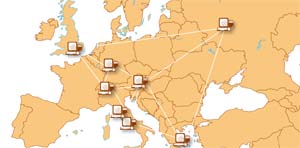Building new cultural knowledge services with BRICKS

Map over the BRICKS network ©Metaware
If citizens are to access the wealth of cultural knowledge, tucked away in books, films, photographs and historical artefacts spread across museums, libraries and archives and if cultural organisations are to make the most out of their resources innovative digital solutions such as those currently being built are needed.
The BRICKS project is creating the building blocks for integrated cultural knowledge services and laying the technological foundations for applications that will provide cultural organisations with new methods to share and exploit their content. Its open source software is being made available for free to museums, archives, libraries and other institutions, allowing them to utilise their cultural content and resources in novel ways while drastically reducing the costs of deploying digital library services.
Part of the problem for cultural organisations to date has been that content, when digitalised, is generally stored in centralised libraries that can limit visibility and access, thereby restricting knowledge and resource sharing between organisations and with the general public.
Another important barrier preventing cultural institutions at the moment to make their digital content accessible over the Web is the copyright management issue. Most of the cultural stakeholders, especially the small and medium sized ones, cannot afford effective Digital Right Management solutions for handling, in a very effective way, the problem of copyright management. BRICKS provides these players with open source, interoperable, vendor-independent and less costly solutions for dealing with the intellectual property problem
BRICKS takes a different approach by using open source software to lay the foundation of a decentralised network based on a peer-to-peer architecture. Each node – there will be 50 in operation in the coming months – containing an organisation’s content is connected to other nodes, allowing sharing between them and increasing visibility, something that is particularly important for smaller cultural organisations.
“Smaller organisations generally lack the financial means to build and maintain their own systems so for them the benefits of joining the BRICKS community are large,” Silvia Boi, the communications director of the IST-funded project, says. “They can simply download the software and add their content to the network at little cost, gaining instant visibility and the ability to share their knowledge across cross-organisational boundaries. The scalability of the system means that the number of nodes that can be added is endless.”
Because the partners have taken a modular approach to the software, the BRICKS system can also be employed effectively even by those institutions that have their own storage and content distribution systems.
Some larger cultural organisations such as the Uffizi library are among the community members, and they, like their smaller counterparts, are all helping to evaluate and improve the technology. Some of these players have decided to become on a voluntary basis ‘early adopters’ of the BRICKS platform. Several technology providers are also involved, as too are cultural organisations from outside of Europe, giving BRICKS a global presence.
“The most important thing for us is to have an active community of members providing feedback and explaining their needs,” Boi notes.
The desire to meet those needs and provide organisations with new ways to use and share their cultural resources has led to four prototype ‘vertical’ user-oriented applications being built upon the foundation of the decentralised network infrastructure.
These ‘pillars’, as they are referred to by the project, include an archaeological information application that aggregates, compares and distributes information about archaeological sites, allowing them to be recreated in multimedia formats online.
A Living Memory application meanwhile allows “new cultural knowledge” to be created, Boi says. “A visitor to an exhibition of World War II photographs would be able to annotate the collection with their memories or feelings, creating new collections of information about the subject,” she explains.
Another application, dubbed Scriptorium, allows different historical texts and manuscripts to be accessed and compared. “The different versions of the Divine Comedy could be annotated and evaluated alongside research texts,” Boi notes.
And there is also a tool to help small and medium museums better manage their resources, and share their knowledge about organising exhibitions, for example.
“These are just four scenarios – the potential applications that can be built with BRICKS are virtually limitless,” Boi says.
The next step for the project is turning the BRICKS Factory into a self-sustaining company that will continue to develop and support the technology and train cultural organisations to use it. “We’re looking at business models that will allow the services and network to continue to evolve after the project ends,” Boi says.
Media Contact
All latest news from the category: Information Technology
Here you can find a summary of innovations in the fields of information and data processing and up-to-date developments on IT equipment and hardware.
This area covers topics such as IT services, IT architectures, IT management and telecommunications.
Newest articles

Properties of new materials for microchips
… can now be measured well. Reseachers of Delft University of Technology demonstrated measuring performance properties of ultrathin silicon membranes. Making ever smaller and more powerful chips requires new ultrathin…

Floating solar’s potential
… to support sustainable development by addressing climate, water, and energy goals holistically. A new study published this week in Nature Energy raises the potential for floating solar photovoltaics (FPV)…

Skyrmions move at record speeds
… a step towards the computing of the future. An international research team led by scientists from the CNRS1 has discovered that the magnetic nanobubbles2 known as skyrmions can be…





















